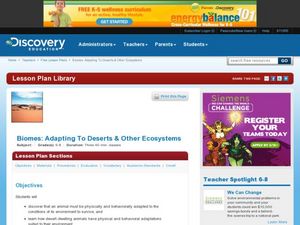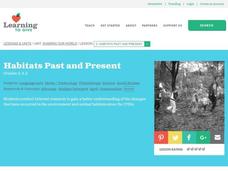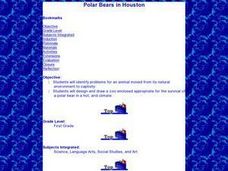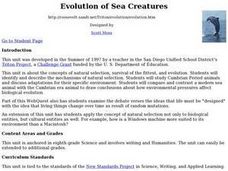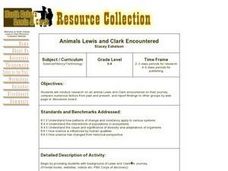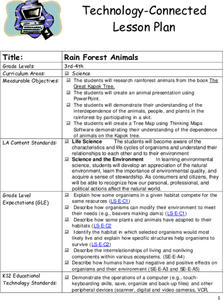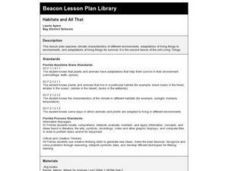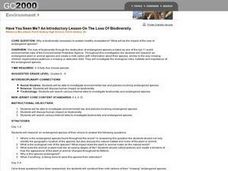Curated OER
Which Animals Should Be Saved?
Fifth graders investigate the concepts related to the endangerment of different animal species. They conduct research using a variety of resources. The skills of prediction are used to show the possible outcome of the extinction of a...
Curated OER
Biomes: Adapting To Deserts & Other Ecosystems
Students examine how animals must be adapted to the conditions of its environment to survive. In this biomes instructional activity students research desert adaptations then discuss how these animals have survived.
Curated OER
Habitats Past and Present
Students explore the changes in animal habitats. In this ecosystem lesson plan, students use the Internet to explore the changes in the environment since the 1700's. Students complete a Venn diagram to compare the differences in the...
Curated OER
It's not just pretty - it's a survival method!
First graders write explanations for why certain animals can only live in certain environments. In this animal survival lesson plan, 1st graders take pictures of animals and place them into the right environment after a lesson on the...
Curated OER
Naturalist's Notebook
Students observe and record the behavior of a San Diego wetland animal and the characteristics of its environment. The amount of time that each animal spends resting, grooming, eating, flying, and social or individual play becomes the...
Curated OER
Polar Bears in Houston
First graders read a book about animal babies from the Arctic and discuss what a polar bear needs to survive. They design a suitable zoo habitat for a polar bear using crayons and paper.
Curated OER
Help! Someone Has Destroyed My Home!
Fifth graders use a mystery bag to discover ways in which humans endanger the life of animals by changing their habitat. In this animal habitat lesson, 5th graders work with a partner to design a solution to the problem of habitat...
Curated OER
Evolution of Sea Creatures
Students identify and describe the mechanisms of natural selection. They study Cambrian Period animals and discuss adaptations for their specific environment.Students compare and contrast a modern sea animal with the Cambrian era animal...
Curated OER
Stormy Weather
Fifth graders compare human and wildlife environments. In this stormy weather lesson, 5th graders imagine they are an animal or human during a storm. Students compose a story with comparisons and reasons for how an organism's...
Curated OER
Animals Lewis and Clark Encountered
Students conduct research on an animal Lewis and Clark encountered on their journey, compare numerous factors from past and present, and report findings to other groups by web page or discussion board.
Curated OER
Populations and Ecosystems
Sixth graders define terms prey, predator, and scavenger, describe predator-prey relationship, discuss effects of a lack of predators in an environment, and separate the role of the scavenger from that of the predator.
Curated OER
Rain Forest Animals
Students research rainforest animals from the book The Great Kapok Tree. They create an animal presentation using PowerPoint. Pupils demonstrate their comprehension of the interdependence of the animals, people, and plants in the...
Curated OER
Galapagos Adaptations
Young scholars examine photographs of closely related species found in the Gal??pagos environment, observe differences and similarities between species, and form hypotheses about species differences and the relationship to the...
Curated OER
City Animals
Students, in groups, conduct research, including interviews of people in various animal related occupations, to identify and describe how animal populations of cities have changed over time, to outline the benefits and problems...
Curated OER
The Parts of an Insect
Learners examine various insects. They discuss the parts of an insect and the environments in which they live. Students explore the importance of insects to our environment. They draw an interpretation of their insect and label its parts.
Curated OER
Critters in Your Own Backyard
Pupils identify various animals and their habitats, as well as their specific traits In this animal habitat instructional activity, students list animals they've seen in their backyard. Pupils select one animal and do research. Students...
Curated OER
Habitats and All That
First graders read books, complete online explorations and discuss the ways in which animals adapt to their habitats in order to survive. They create accordion books, play matching games and dramatize animal adaptations.
Curated OER
Life at Risk
Students examine the characteristics of the peregrine falcon. They investigate endangered and extinct species, and how the environment affects the process.
Curated OER
Vanished!
Students research how certain types of animals became extinct, and write report about their chosen species, explaining scientific theories or facts about how it became extinct, and how extinction has affected other species and the...
Curated OER
Common Adaptation Patterns
Students become familiar with common categories of animals and discover adaptation patterns and structures in animals that help them survive in different environments. Students identify major structures of common animals.
Curated OER
Have You Seen Me? An Introductory Lesson on the Loss of Biodiversity
Students investigate environmental law and policies involving endangered species as well as discuss human impact on biodiversity through an Internet research project. Students create a milk carton of their "missing" endangered species.
Curated OER
Ecosystem Worksheet
In this environment worksheet, students find the words that are related to the ecosystem. The vocabulary is used to help develop environmental awareness.
Curated OER
Who's New in the Deep Sea?
Students examine the methods and technology that scientists use to study the deep sea and other remote environments. For this ocean habitats lesson students make observations about organisms from video clips, generate questions and...
Curated OER
Conservation and Environmental Protection
Students brainstorm a list of environments and animals from around the world that need protection. They then design and create a slogan about an animal or environment and an environmental protection poster.

